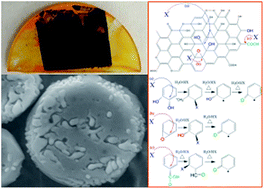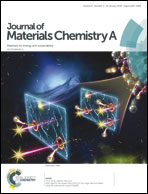Oxygen-induced defects at the lead halide perovskite/graphene oxide interfaces†
Abstract
Graphene oxide or its reduced derivative (GO/RGO) replace metal oxides in perovskite photovoltaics to achieve energy band alignment for minimization of the energy barriers at the film interfaces allowing efficient charge transport, and eliminate stability issues. However, the power conversion efficiencies fall in a wide range (∼0.6–18%). Therefore, the perovskite growth and nucleation on GO/RGO require fundamental understanding to improve device function for controlled fabrication, which remain a major challenge. We analyze the surface morphology and crystallization of the lead halide perovskites (MAPbX3) at 20–300 °C on GO using X-ray diffraction and photoelectron spectroscopy. To determine defect mechanisms and their composition, we perform in situ transmission infrared and micro Raman spectroscopy, and the cross-sectional scanning microscopy that captures interfacial imperfections with the oxygen defects. We demonstrate the oxygen-induced defects at the MAPbX3/GO interfaces that initiate at room temperature, and occur through the nucleophilic substitution reactions. Unexpectedly, structural defects nucleate in GO forming chemically reduced GO, and modify the surface morphology that yield a poor perovskite growth. Our theoretical studies also reveal that energetically favorable, exothermic reactions between the halides of the perovskite precursors and the oxygen groups of GO generate acidic reaction by-products (i.e. HX), that confirm the formation of oxygen-induced defects.

- This article is part of the themed collection: 2018 Journal of Materials Chemistry A HOT Papers


 Please wait while we load your content...
Please wait while we load your content...